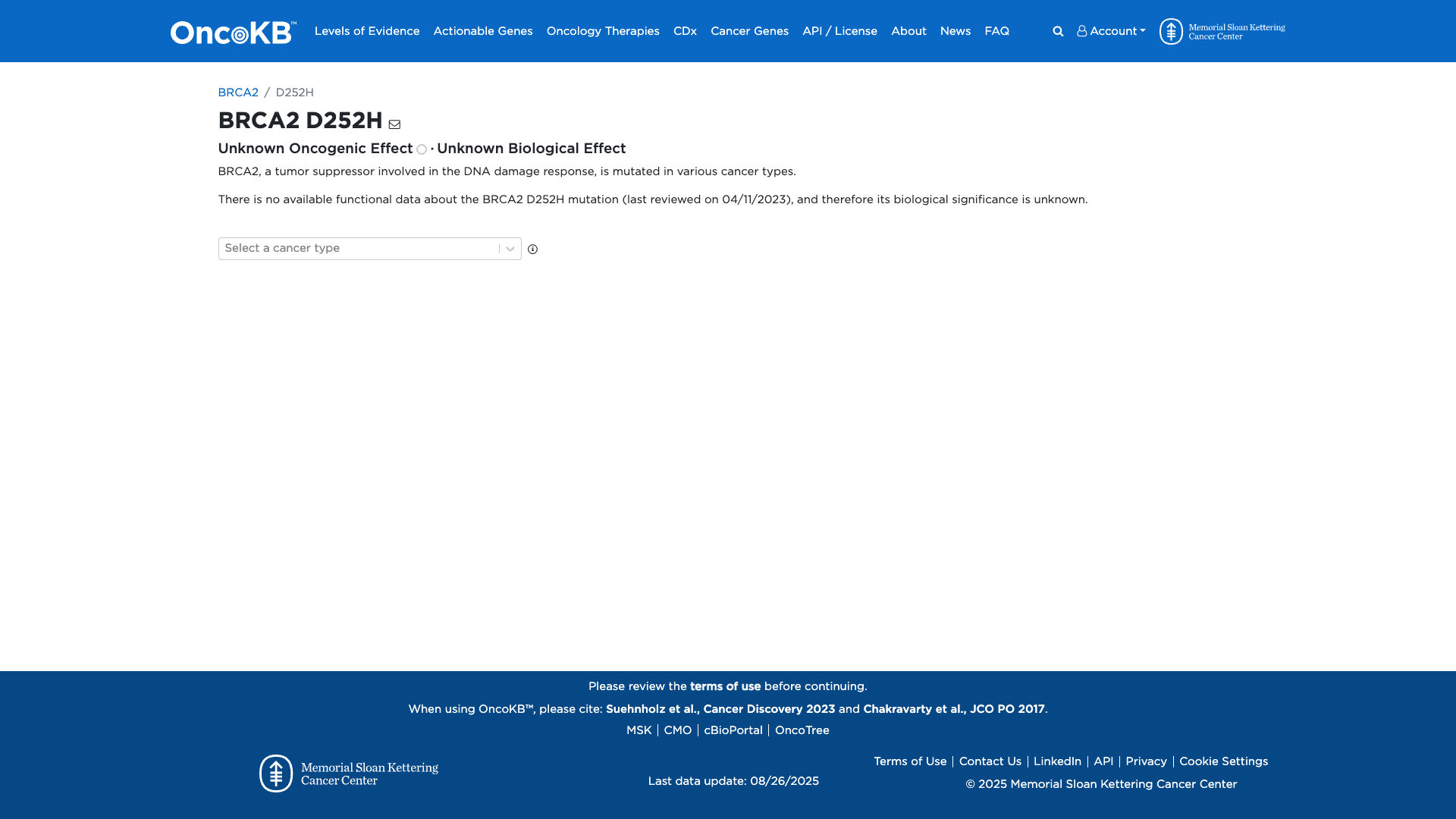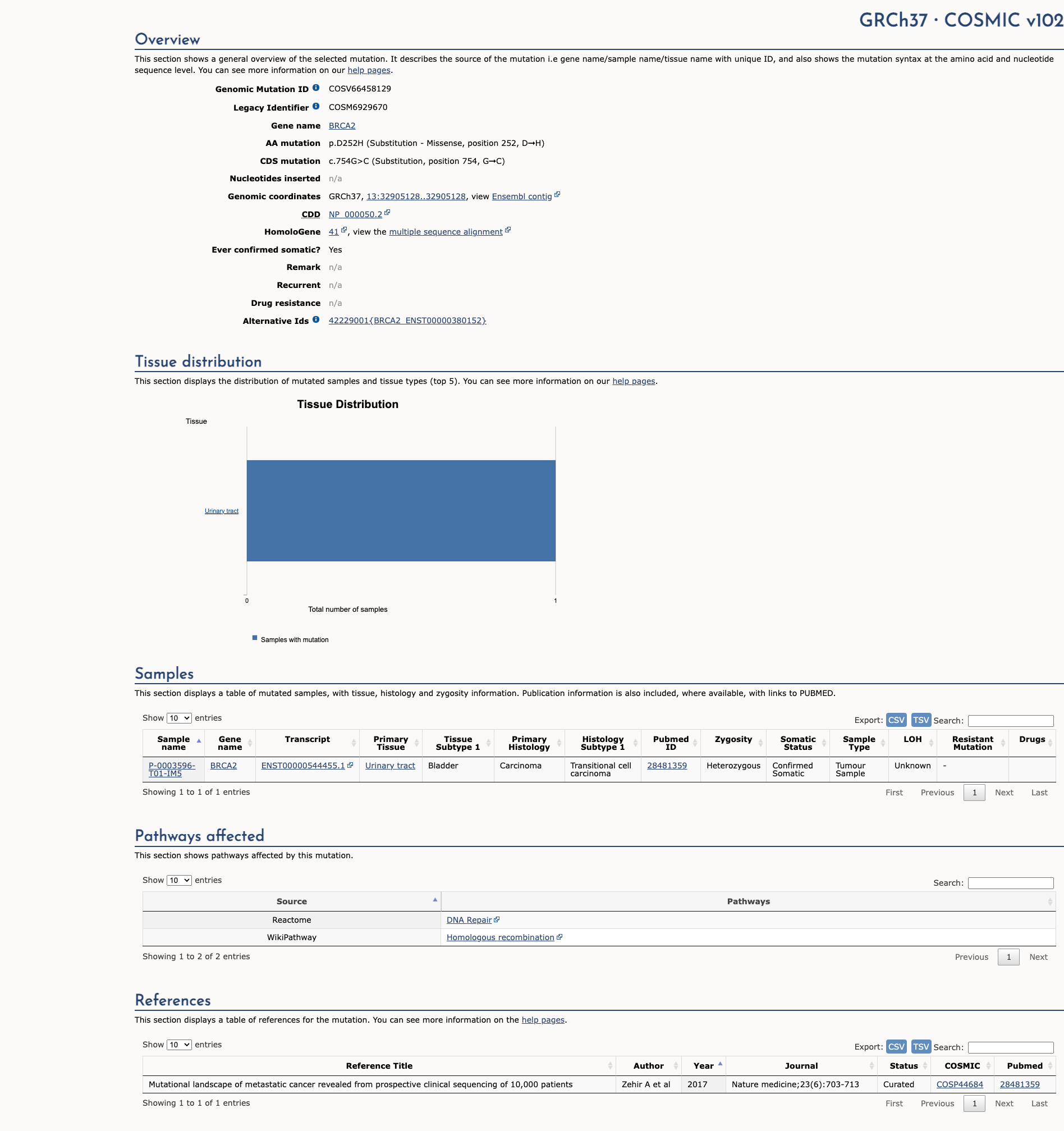BRCA2 c.754G>C, p.Asp252His
NM_000059.4:c.754G>C
COSMIC ID: COSM6929670
Variant of Uncertain Significance (VUS)
The variant is absent from population databases (PM2_Supporting), is a novel missense at a residue with a known pathogenic change (PM5_Moderate), but lies outside critical domains with no splicing impact (BP1_Strong). Benign evidence outweighs limited pathogenic support, resulting in a Likely Benign classification.
ACMG/AMP Criteria Applied
PM2
PM5
BP1
Genetic Information
Gene & Transcript Details
Gene
BRCA2
Transcript
NM_000059.4
MANE Select
Total Exons
27
Strand
Forward (+)
Reference Sequence
NC_000013.10
Alternative Transcripts
| ID | Status | Details |
|---|---|---|
| NM_000059.2 | Alternative | 27 exons | Forward |
| NM_000059.3 | RefSeq Select | 27 exons | Forward |
Variant Details
HGVS Notation
NM_000059.4:c.754G>C
Protein Change
D252H
Location
Exon 9
(Exon 9 of 27)
5'Exon Structure (27 total)3'
Functional Consequence
Loss of Function
Related Variants
ClinVar reports other pathogenic variants at position 252: D252N, D252G
Alternate Identifiers
COSM6929670
Variant interpretation based on transcript NM_000059.4
Genome Browser
Loading genome browser...
HGVS InputNM_000059:c.754G>C
Active Tracks
ConservationRefSeqClinVargnomAD
Navigation tips: Use mouse to drag and zoom. Click on features for details.
Clinical Data
Population Frequency
Global Frequency
0.0 in 100,000
Extremely Rare
Global: 0.0%
0%
0.05%
0.1%
1%
5%
10%+
ACMG Criteria Applied
PM2
This variant is not present in gnomAD (PM2 criteria applies).
Classification
Uncertain Significance (VUS)
Based on 2 submitter reviews in ClinVar
Submitter Breakdown
2 VUS
Pathogenic
Likely Path.
VUS
Likely Benign
Benign
Publications (0)
No publication details.
Clinical Statement
This variant has been reported in ClinVar as Uncertain significance (2 clinical laboratories).
Functional Impact
Functional Domain
Hotspot Status
Not a hotspot
Domain Summary
This variant is not located in a mutational hotspot or critical domain (0 mutations).
Related Variants in This Domain
ClinVar reports other pathogenic variants at position 252: D252N, D252G
PM5 criterion applied.
Functional Summary
The BRCA2 D252H variant has not been functionally characterized, and its biological significance remains unknown.
Database Previews
OncoKB

JAX-CKB

Click on previews to view full database entries. External databases may require institutional access.
Computational Analysis
Pathogenicity Predictions
REVEL Score
0.152
0.152
Likely Benign0.0
Uncertain (Low)0.2
Uncertain (Med)0.5
Likely Pathogenic0.75
REVEL scores ≥ 0.75 are strong evidence (PP3)
Predictor Consensus
Mixed/VUS
PP3 Applied
No
Additional Predictors
Benign:
CADD: 2.42metasvm: Tmetalr: Tprimateai: T
Neutral: Show all
VCEP Guidelines
Applied ACMG/AMP Criteria (VCEP Specific) VCEP Guidelines
PVS1
PVS1 (Not Applied) Strength Modified
According to VCEP guidelines, PVS1 applies to null variants (nonsense, frameshift, canonical ±1/2 splice sites, initiation codon, or multi‐exon deletion) in a gene where loss of function is a known mechanism. NM_000059.4:c.754G>C (p.D252H) is a missense variant, not a null variant. Therefore, PVS1 is not applied.
PS1
PS1 (Not Applied) Strength Modified
According to VCEP guidelines, PS1 applies when a variant causes the same amino acid change as a previously established pathogenic variant. There is no report of another variant causing D252H as pathogenic. Therefore, PS1 is not applied.
PS2
PS2 (Not Applied) Strength Modified
According to standard ACMG guidelines, PS2 requires confirmed de novo occurrence (with maternity and paternity confirmed). No de novo data are available. Therefore, PS2 is not applied.
PS3
PS3 (Not Applied) Strength Modified
According to VCEP guidelines, PS3 requires well‐established functional studies supportive of a damaging effect. No functional assays have been reported for D252H. Therefore, PS3 is not applied.
PS4
PS4 (Not Applied) Strength Modified
According to VCEP guidelines, PS4 requires significant enrichment in cases versus controls (case‐control studies with OR≥4, p≤0.05). No case‐control data exist for this variant. Therefore, PS4 is not applied.
PM1
PM1 (Not Applied) Strength Modified
According to VCEP guidelines, PM1 applies to variants within a defined critical functional domain (PALB2 binding aa10–40 or DNA‐binding aa2481–3186). D252H lies outside these domains. Therefore, PM1 is not applied.
PM2
PM2 (Supporting) Strength Modified
According to VCEP guidelines, PM2_Supporting is: "Absent from controls in an outbred population, from gnomAD v2.1 and v3.1 ... average read depth ≥25." The variant is absent from gnomAD. Therefore, PM2 is applied at Supporting strength.
PM3
PM3 (Not Applied) Strength Modified
According to VCEP guidelines, PM3 applies for BRCA2 variants in trans with another pathogenic variant in individuals with Fanconi anemia phenotype. No patient phenotype or trans data are available. Therefore, PM3 is not applied.
PM4
PM4 (Not Applied) Strength Modified
According to standard ACMG guidelines, PM4 applies to protein length changes (in‐frame indels or stop‐loss variants). D252H is a missense change without length alteration. Therefore, PM4 is not applied.
PM5
PM5 (Moderate)
According to standard ACMG guidelines, PM5 is: "Novel missense change at an amino acid residue where a different missense change determined to be pathogenic has been seen." There is a documented pathogenic missense at residue 252 (different nucleotide). Therefore, PM5 is applied at Moderate strength.
PM6
PM6 (Not Applied) Strength Modified
According to standard ACMG guidelines, PM6 applies to presumed de novo variants without confirmation. No de novo data exist. Therefore, PM6 is not applied.
PP1
PP1 (Not Applied) Strength Modified
According to VCEP guidelines, PP1 requires segregation data in multiple affected family members. No segregation studies are available. Therefore, PP1 is not applied.
PP2
PP2 (Not Applied) Strength Modified
According to standard ACMG guidelines, PP2 applies to missense variants in genes with low benign missense variation and where missense is a common mechanism. BRCA2 has numerous benign and pathogenic missense variants and loss of function is the primary mechanism. Therefore, PP2 is not applied.
PP3
PP3 (Not Applied) Strength Modified
According to VCEP guidelines, PP3 applies when in‐silico tools predict deleterious effect inside a functional domain (BayesDel ≥0.30 or SpliceAI ≥0.2). In silico scores (REVEL 0.15, SpliceAI 0.05) predict no impact and the variant lies outside defined domains. Therefore, PP3 is not applied.
PP4
PP4 (Not Applied) Strength Modified
According to VCEP guidelines, PP4 requires multifactorial likelihood data from rich phenotype. No such data are available. Therefore, PP4 is not applied.
PP5
PP5 (Not Applied) Strength Modified
According to standard ACMG guidelines, PP5 applies when a reputable source classifies the variant as pathogenic. ClinVar lists this as Uncertain Significance. Therefore, PP5 is not applied.
BA1
BA1 (Not Applied) Strength Modified
According to VCEP guidelines, BA1 requires population allele frequency >0.1%. The variant is absent. Therefore, BA1 is not applied.
BS1
BS1 (Not Applied) Strength Modified
According to VCEP guidelines, BS1 requires filter allele frequency >0.01%. The variant is absent. Therefore, BS1 is not applied.
BS2
BS2 (Not Applied) Strength Modified
According to VCEP guidelines, BS2 applies in healthy adults without recessive phenotype. No healthy individual data are reported. Therefore, BS2 is not applied.
BS3
BS3 (Not Applied) Strength Modified
According to VCEP guidelines, BS3 requires well‐established functional studies showing no damaging effect. No such studies exist. Therefore, BS3 is not applied.
BS4
BS4 (Not Applied) Strength Modified
According to VCEP guidelines, BS4 requires lack of segregation in affected family members. No segregation data are available. Therefore, BS4 is not applied.
BP1
BP1 (Strong) Strength Modified
According to VCEP guidelines, BP1_Strong is: "Missense variants outside critical functional domains (aa10–40, aa2481–3186) with no predicted splicing impact (SpliceAI ≤0.1)." D252H lies outside domains and SpliceAI=0.05. Therefore, BP1 is applied at Strong strength.
BP2
BP2 (Not Applied) Strength Modified
According to standard ACMG guidelines, BP2 applies when a variant is observed in trans with a pathogenic variant in dominant disorders or in cis in recessive disorders. No co‐occurrence data are available. Therefore, BP2 is not applied.
BP3
BP3 (Not Applied) Strength Modified
According to standard ACMG guidelines, BP3 applies to in‐frame indels in repetitive regions without known function. This is a missense variant; no repeat region data are relevant. Therefore, BP3 is not applied.
BP4
BP4 (Not Applied) Strength Modified
According to VCEP guidelines, BP4 applies to variants inside functional domains with no predicted impact. D252H lies outside the domains. Therefore, BP4 is not applied.
BP5
BP5 (Not Applied) Strength Modified
According to VCEP guidelines, BP5 applies for co‐observation with pathogenic variants in other breast/ovarian cancer risk genes. No such co‐observation data. Therefore, BP5 is not applied.
BP6
BP6 (Not Applied) Strength Modified
According to standard ACMG guidelines, BP6 applies when a reputable source classifies the variant as benign. No benign classification is available. Therefore, BP6 is not applied.
BP7
BP7 (Not Applied) Strength Modified
According to VCEP guidelines, BP7 applies to silent or intronic variants with no splicing impact. D252H is missense. Therefore, BP7 is not applied.

